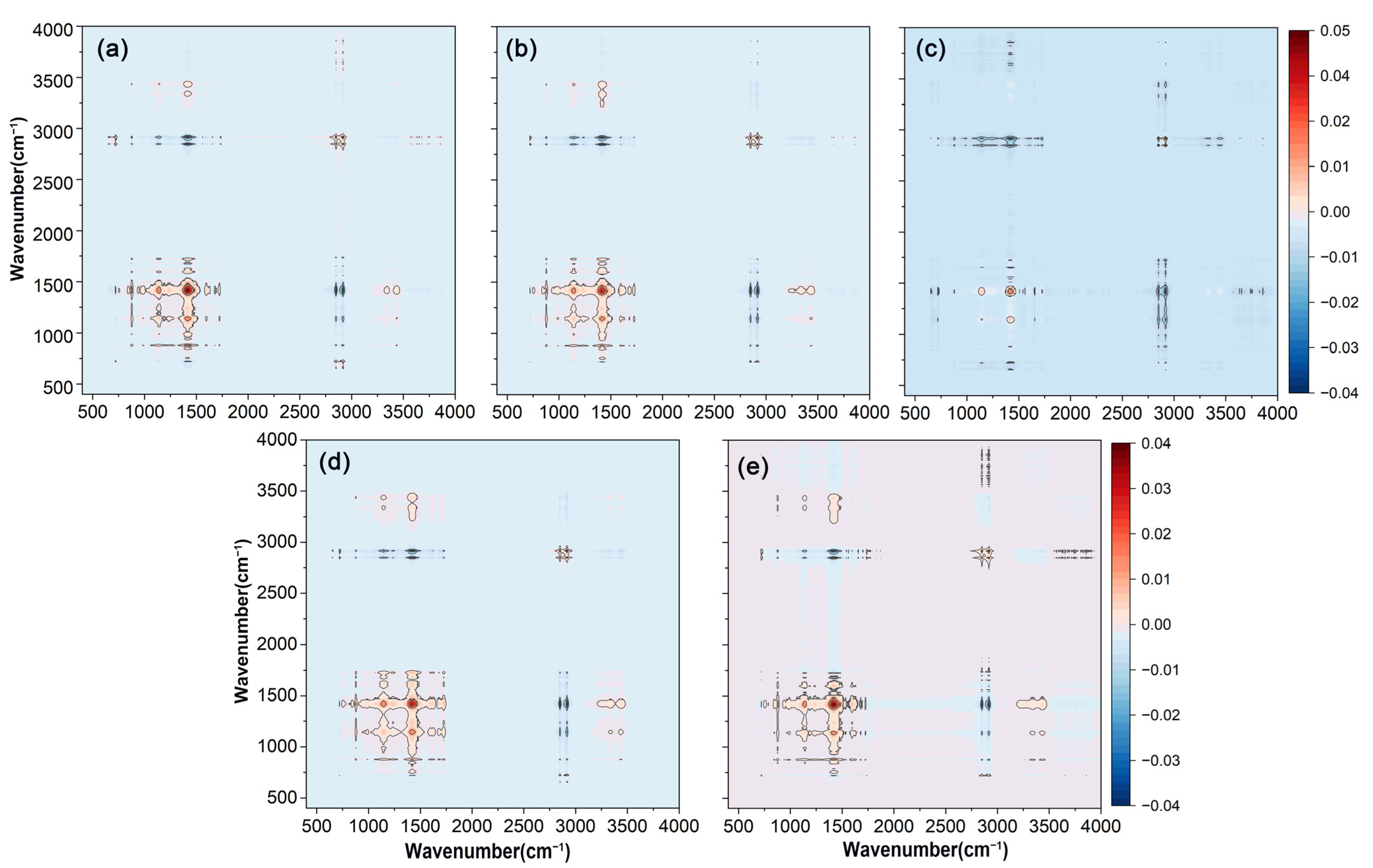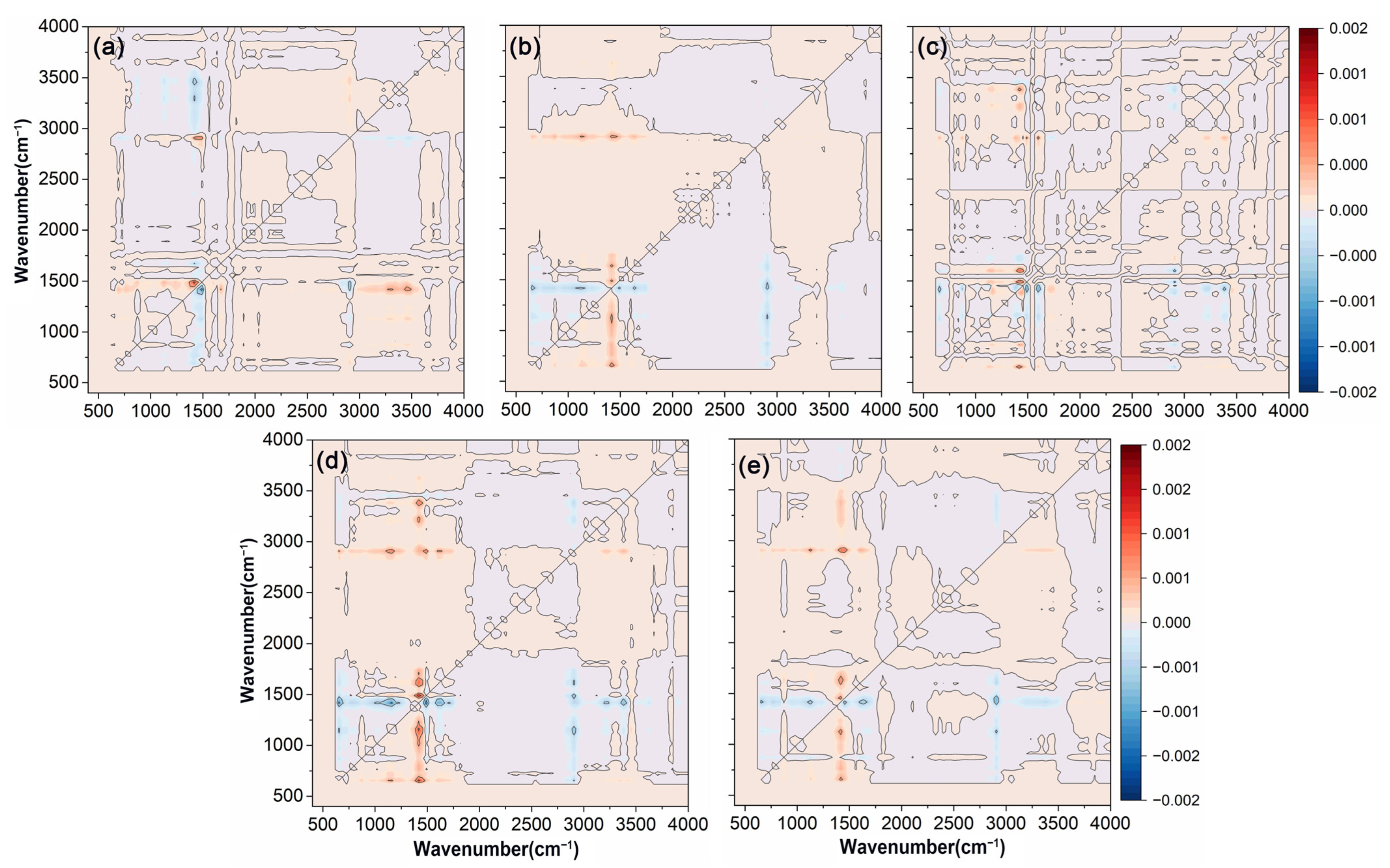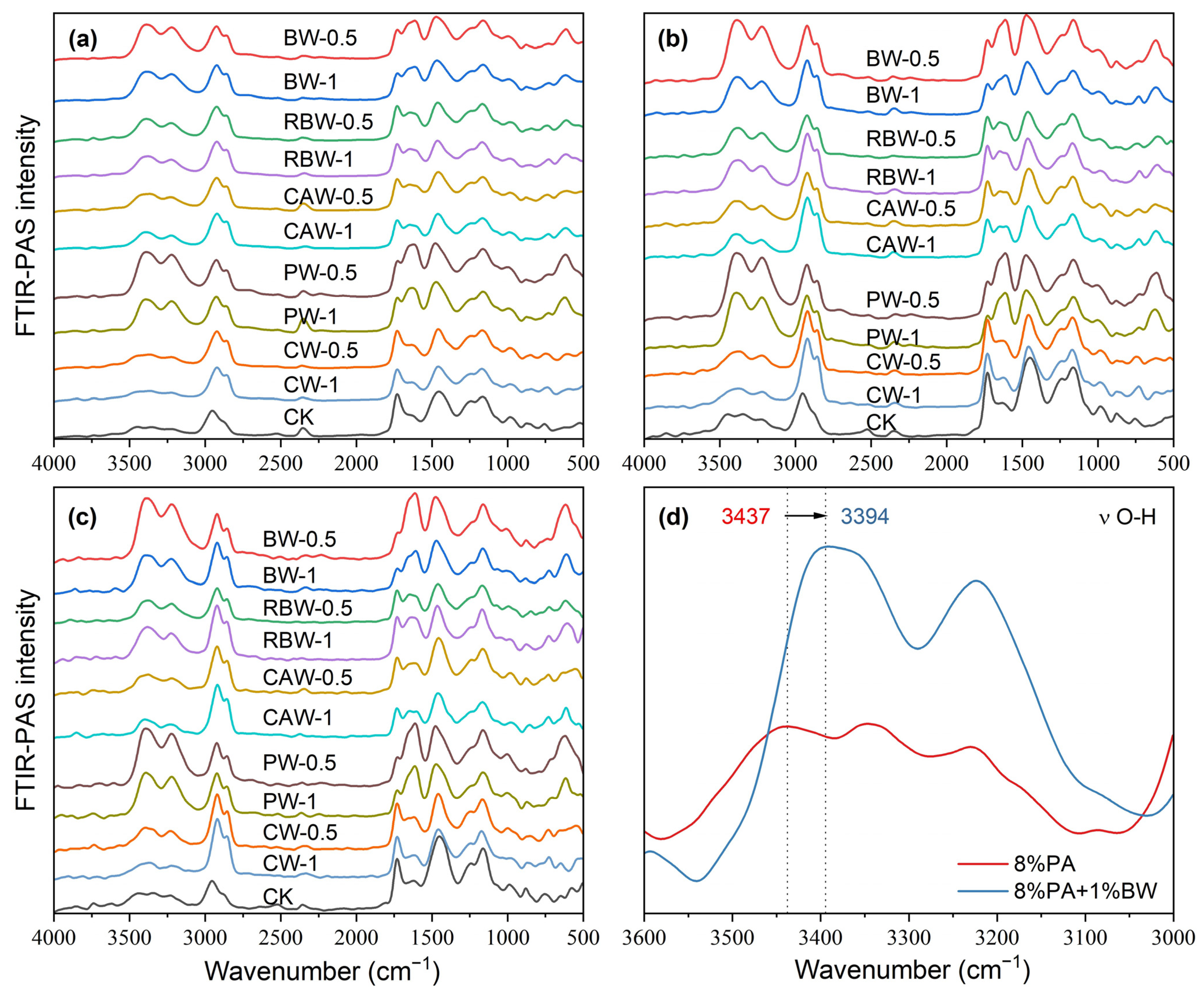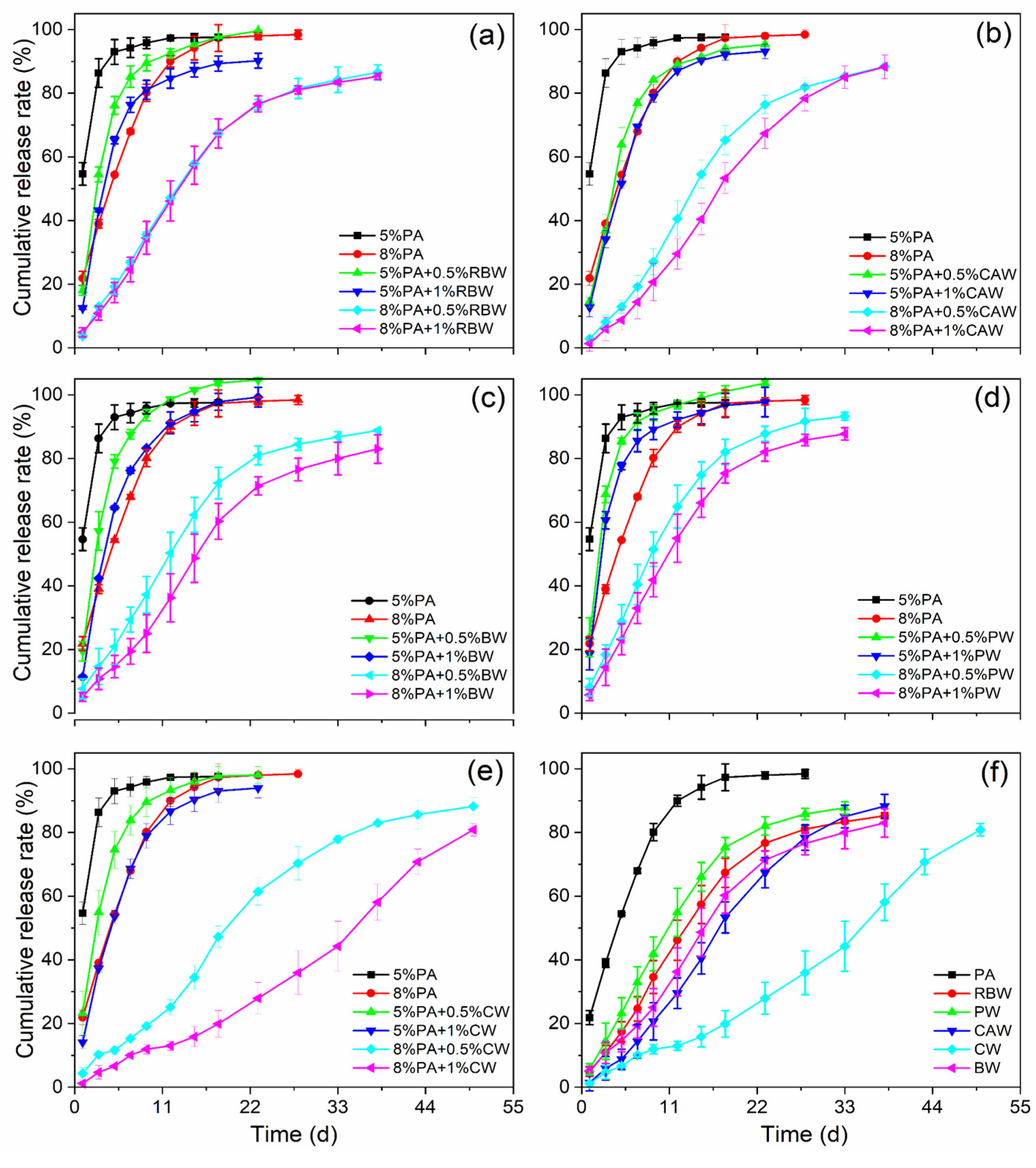Biomimetic Modification of Waterborne Polymer Coating Using Bio-Wax for Enhancing Controlled Release Performance of Nutrient
Abstract
1. Introduction
2. Materials and Methods
2.1. Materials
2.2. Synthesis of Polyacrylate Emulsion
2.3. Preparation of Polyacrylate-Coated Urea (PACU)
2.4. Preparation of Wax-Modified Polyacrylate-Coated Urea (PACU)
2.5. Characterization of the Coating
2.6. Nutrient Release Profile
2.7. Field Experiments
2.8. Statistical Analysis
3. Results
3.1. Variations and Morphologies of Wax-Modified Polyacrylate-Coated Urea (WPACU)
3.2. Characterization of Wax-Modified Polyacrylate-Coated Urea (WPACU)
3.3. Release Performances
3.4. Field Applications of Wax-Modified Polyacrylate-Coated Urea (WPACU)
4. Conclusions
Author Contributions
Funding
Data Availability Statement
Conflicts of Interest
Abbreviations
| CAW | Candelilla Wax |
| CRFs | Controlled Release Fertilizers |
| CW | Carnauba Wax |
| BW | Bees wax |
| FTIR-ATR | Fourier Transform Infrared Attenuated Total Reflectance Spectroscopy |
| NUE | Nitrogen Use Efficiency |
| PACU | Polyacrylate-Coated Urea |
| PW | Paraffin Wax |
| RBW | Rice Bran Wax |
| SEM | Scanning Electron Microscopy |
| WPACU | Wax-Modified Polyacrylate-Coated Urea |
References
- Abbas, A.; Wang, Z.; Zhang, Y.; Peng, P.; She, D. Lignin-based controlled release fertilizers: A review. Int. J. Biol. Macromol. 2022, 222, 1801–1817. [Google Scholar] [CrossRef] [PubMed]
- Naz, M.Y.; Sulaiman, S.A. Slow release coating remedy for nitrogen loss from conventional urea: A review. J. Control. Release 2016, 225, 109–120. [Google Scholar] [CrossRef] [PubMed]
- Vejan, P.; Khadiran, T.; Abdullah, R.; Ahmad, N. Controlled release fertilizer: A review on developments, applications and potential in agriculture. J. Control. Release 2021, 339, 321–334. [Google Scholar] [CrossRef]
- Robertson, G.P.; Vitousek, P.M. Nitrogen in agriculture: Balancing the cost of an essential resource. Annu. Rev. Environ. Resour. 2009, 34, 97–125. [Google Scholar] [CrossRef]
- Chien, S.H.; Prochnow, L.I.; Cantarella, H. Recent developments of fertilizer production and use to improve nutrient efficiency and minimize environmental impacts. Adv. Agron. 2009, 102, 267–322. [Google Scholar]
- He, Y.; Lehndorff, E.; Amelung, W.; Wassmann, R.; Alberto, M.C.; von Unold, G.; Siemens, J. Drainage and leaching losses of nitrogen and dissolved organic carbon after introducing maize into a continuous paddy-rice crop rotation. Agric. Ecosyst. Environ. 2017, 249, 91–100. [Google Scholar] [CrossRef]
- Coskun, D.; Britto, D.T.; Shi, W.M.; Kronzucker, H.J. Nitrogen transformations in modern agriculture and the role of biological nitrification inhibition. Nat. Plants 2017, 3, 17074. [Google Scholar] [CrossRef]
- Maghsoodi, M.R.; Najafi, N.; Reyhanitabar, A.; Oustan, S. Hydroxyapatite nanorods, hydrochar, biochar, and zeolite for controlled-release urea fertilizers. Geoderma 2020, 379, 114644. [Google Scholar] [CrossRef]
- González, M.E.; Cea, M.; Medina, J.; González, A.; Diez, M.C.; Cartes, P.; Monreal, C.; Navia, R. Evaluation of biodegradable polymers as encapsulating agents for the development of a urea controlled-release fertilizer using biochar as support material. Sci. Total Environ. 2015, 505, 446–453. [Google Scholar] [CrossRef]
- Linquist, B.A.; Adviento-Borbe, M.A.; Pittelkow, C.M.; van Kessel, C.; van Groenigen, K.J. Fertilizer management practices and greenhouse gas emissions from rice systems: A quantitative review and analysis. Field Crops Res. 2012, 135, 10–21. [Google Scholar] [CrossRef]
- Azeem, B.; KuShaari, K.; Man, Z.B.; Basit, A.; Thanh, T.H. Review on materials & methods to produce controlled release coated urea fertilizer. J. Control. Release 2014, 181, 11–21. [Google Scholar]
- Ye, H.M.; Li, H.F.; Wang, C.S.; Yang, J.X.; Huang, G.Y.; Meng, X.Y.; Zhou, Q. Degradable polyester/urea inclusion complex applied as a facile and environment-friendly strategy for slow-release fertilizer: Performance and mechanism. Chem. Eng. J. 2020, 381, 122704. [Google Scholar]
- Fertahi, S.; Ilsouk, M.; Zeroual, Y.; Oukarroum, A.; Barakat, A. Recent trends in organic coating based on biopolymers and biomass for controlled and slow release fertilizers. J. Control. Release 2021, 330, 341–361. [Google Scholar] [PubMed]
- Semenova, N.A.; Burmistrov, D.E.; Shumeyko, S.A.; Gudkov, S.V. Fertilizers Based on Nanoparticles as Sources of Macro- and Microelements for Plant Crop Growth: A Review. Agronomy 2024, 14, 1646. [Google Scholar] [CrossRef]
- Irfan, S.A.; Razali, R.; KuShaari, K.; Mansor, N.; Azeem, B.; Ford Versypt, A.N. A review of mathematical modeling and simulation of controlled-release fertilizers. J. Control. Release 2018, 271, 45–54. [Google Scholar] [PubMed]
- Shaviv, A. Advances in controlled-release fertilizers. Adv. Agron. 2001, 71, 1–49. [Google Scholar]
- Chen, J.; Lü, S.; Zhang, Z.; Zhao, X.; Li, X.; Ning, P.; Liu, M. Environmentally friendly fertilizers: A review of materials used and their effects on the environment. Sci. Total Environ. 2018, 613–614, 829–839. [Google Scholar]
- Lu, H.; Dun, C.; Jariwala, H.; Wang, R.; Cui, P.; Zhang, H.; Dai, Q.; Yang, S.; Zhang, H. Improvement of bio-based polyurethane and its optimal application in controlled release fertilizer. J. Control. Release 2022, 350, 748–760. [Google Scholar]
- Dimkpa, C.O.; Fugice, J.; Singh, U.; Lewis, T.D. Development of fertilizers for enhanced nitrogen use efficiency—Trends and perspectives. Sci. Total Environ. 2020, 731, 139113. [Google Scholar]
- Tian, H.Y.; Liu, Z.G.; Zhang, M.; Guo, Y.L.; Zheng, L.; Li, Y.C.C. Biobased polyurethane, epoxy resin, and polyolefin wax composite coating for controlled-release fertilizer. ACS Appl. Mater. Interfaces 2019, 11, 5380–5392. [Google Scholar]
- Qiao, D.; Liu, H.; Yu, L.; Bao, X.; Simon, G.P.; Petinakis, E.; Chen, L. Preparation and characterization of slow-release fertilizer encapsulated by starch-based superabsorbent polymer. Carbohydr. Polym. 2016, 147, 146–154. [Google Scholar] [CrossRef] [PubMed]
- Zhang, S.G.; Fu, X.J.; Tong, Z.H.; Liu, G.D.; Meng, S.Y.; Yang, Y.C.; Helal, M.I.D.; Li, Y.C. Lignin-clay nanohybrid biocomposite-based double-layer coating materials for controllable-release fertilizer. ACS Sustain. Chem. Eng. 2020, 8, 18957–18965. [Google Scholar] [CrossRef]
- Zhang, S.; Shen, T.; Yang, Y.; Ma, X.; Gao, B.; Li, Y.C.; Wang, P. Novel environment-friendly superhydrophobic bio-based polymer derived from liquefied corncob for controlled-released fertilizer. Prog. Org. Coat. 2021, 151, 106018. [Google Scholar] [CrossRef]
- Ma, X.; Chen, J.; Yang, Y.; Su, X.; Zhang, S.; Gao, B.; Li, Y.C. Siloxane and polyether dual modification improves hydrophobicity and interpenetrating polymer network of bio-polymer for coated fertilizers with enhanced slow release characteristics. Chem. Eng. J. 2018, 350, 1125–1134. [Google Scholar] [CrossRef]
- Yuan, S.N.; Cheng, L.; Tan, Z.X. Characteristics and preparation of oil-coated fertilizers: A review. J. Control. Release 2022, 345, 675–684. [Google Scholar] [CrossRef]
- Shen, Y.Z.; Zhou, J.M.; Du, C.W.; Zhou, Z.J. Hydrophobic modification of waterborne polymer slows urea release and improves nitrogen use efficiency in rice. Sci. Total Environ. 2021, 794, 148612. [Google Scholar] [CrossRef]
- Liang, D.; Du, C.W.; Ma, F.; Shen, Y.Z.; Wu, K.; Zhou, J.M. Interaction between polyacrylate coatings used in controlled-release fertilizers and soils in wheat-rice rotation fields. Agric. Ecosyst. Environ. 2019, 286, 106650. [Google Scholar] [CrossRef]
- Liang, D.; Du, C.W.; Ma, F.; Shen, Y.Z.; Wu, K.; Zhou, J.M. Degradation of Polyacrylate in the Outdoor Agricultural Soil Measured by FTIR-PAS and LIBS. Polymers 2018, 10, 1296. [Google Scholar] [CrossRef]
- Zhou, Z.J.; Du, C.W.; Li, T.; Shen, Y.Z.; Zeng, Y.; Du, J.; Zhou, J.M. Biodegradation of a biochar-modified waterborne polyacrylate membrane coating for controlled-release fertilizer and its effects on soil bacterial community profiles. Environ. Sci. Pollut. Res. 2015, 22, 8672–8682. [Google Scholar] [CrossRef]
- Ang, C.Y.; Tan, S.Y.; Wang, X.L.; Zhang, Q.; Khan, M.; Bai, L.Y.; Selvan, S.T.; Ma, X.; Zhu, L.L.; Nguyen, K.T.; et al. Supramolecular nanoparticle carriers self-assembled from cyclodextrin- and adamantane-functionalized polyacrylates for tumor-targeted drug delivery. J. Mater. Chem. B 2014, 2, 1879–1890. [Google Scholar] [CrossRef]
- Viola, M.; Migliorini, C.; Ziarelli, F.; Viel, S.; Cencetti, C.; Di Risola, D.; Mosca, L.; Masuelli, L.; Matricardi, P.; Di Meo, C. Polyacrylate-Cholesterol Amphiphilic Derivative: Formulation Development and Scale-up for Health Care Applications. J. Funct. Biomater. 2023, 14, 482. [Google Scholar] [CrossRef] [PubMed]
- Shen, Y.Z.; Zhao, C.; Zhou, J.M.; Du, C.W. Application of waterborne acrylic emulsions in coated controlled release fertilizer using reacted layer technology. Chin. J. Chem. Eng. 2015, 23, 309–314. [Google Scholar] [CrossRef]
- Shen, Y.; Zhou, J.; Du, C. Development of a polyacrylate/silica nanoparticle hybrid emulsion for delaying nutrient release in coated controlled-release urea. Coatings 2019, 9, 88. [Google Scholar] [CrossRef]
- Zhao, X.; Ma, J.; Ma, H.; Gao, D.; Sun, Y.; Guo, C. Removal of polyacrylate in aqueous solution by activated sludge: Characteristics and mechanisms. J. Clean. Prod. 2018, 178, 59–66. [Google Scholar]
- Tang, Q.; Wu, J.; Lin, J. A multifunctional hydrogel with high conductivity, pH-responsive, thermo-responsive and release properties from polyacrylate/polyaniline hybrid. Carbohydr. Polym. 2008, 73, 315–321. [Google Scholar] [CrossRef]
- Zhang, S.; Gao, N.; Shen, T.; Yang, Y.; Gao, B.; Li, Y.C.; Wan, Y. One-step synthesis of superhydrophobic and multifunctional nano copper-modified bio-polyurethane for controlled-release fertilizers with “multilayer air shields”: New insight of improvement mechanism. J. Mater. Chem. A 2019, 7, 9503–9509. [Google Scholar]
- Darmanin, T.; Guittard, F. Superhydrophobic and superoleophobic properties in nature. Mater. Today 2015, 18, 273–285. [Google Scholar] [CrossRef]
- Feng, L.; Li, S.H.; Li, Y.S.; Li, H.J.; Zhang, L.J.; Zhai, J.; Song, Y.L.; Liu, B.Q.; Jiang, L.; Zhu, D.B. Super-hydrophobic surfaces: From natural to artificial. Adv. Mater. 2002, 14, 1857–1860. [Google Scholar] [CrossRef]
- Yong, J.L.; Chen, F.; Yang, Q.; Huo, J.L.; Hou, X. Superoleophobic surfaces. Chem. Soc. Rev. 2017, 46, 4168–4217. [Google Scholar] [CrossRef]
- Bayer, I.S. Superhydrophobic coatings from ecofriendly materials and processes: A review. Adv. Mater. Interfaces 2020, 7, 2000095. [Google Scholar]
- Doan, C.D.; To, C.M.; De Vrieze, M.; Lynen, F.; Danthine, S.; Brown, A.; Dewettinck, K.; Patel, A.R. Chemical profiling of the major components in natural waxes to elucidate their role in liquid oil structuring. Food Chem. 2017, 214, 717–725. [Google Scholar] [PubMed]
- Regert, M. Direct mass spectrometry to characterize wax and lipid materials. In Organic Mass Spectrometry in Art and Archaeology; John Wiley & Sons, Ltd.: Hoboken, NJ, USA, 2009; pp. 97–129. [Google Scholar]
- Ge, C.; Xu, X.; Ma, F.; Zhou, J.; Du, C. Biomimetic Modification of Water-Borne Polymer Coating with Carnauba Wax for Controlled Release of Urea. Int. J. Mol. Sci. 2022, 23, 7422. [Google Scholar] [CrossRef] [PubMed]
- El Assimi, T.; Lakbita, O.; El Meziane, A.; Khouloud, M.; Dahchour, A.; Beniazza, R.; Boulif, R.; Raihane, M.; Lahcini, M. Sustainable coating material based on chitosan-clay composite and paraffin wax for slow-release DAP fertilizer. Int. J. Biol. Macromol. 2020, 161, 492–502. [Google Scholar] [CrossRef] [PubMed]
- Liu, B.Y.; Xue, C.H.; An, Q.F.; Jia, S.T.; Xu, M.M. Fabrication of superhydrophobic coatings with edible materials for super-repelling non-Newtonian liquid foods. Chem. Eng. J. 2019, 371, 833–841. [Google Scholar]
- Zhang, W.; Lu, P.; Qian, L.; Xiao, H. Fabrication of superhydrophobic paper surface via wax mixture coating. Chem. Eng. J. 2014, 250, 431–436. [Google Scholar] [CrossRef]
- Ghazani, S.M.; Dobson, S.; Marangoni, A.G. Hardness, plasticity, and oil binding capacity of binary mixtures of natural waxes in oliveoil. Curr. Res. Food Sci. 2022, 5, 998–1008. [Google Scholar]
- Al-Shehri, B.M.; Haddadi, T.; M. Alasmari, E.; Ghramh, H.A.; Khan, K.A.; Mohammed, M.E.A.; Sager Alotaibi, M.; El-Niweiri, M.A.A.; Hamdi Assiri, A.; Khayyat, M.M. Effect of storage time and floral origin on the physicochemical properties of beeswax and the possibility of using it as a phase changing material in the thermal storage energy technology. Foods 2022, 11, 3920. [Google Scholar] [CrossRef]
- Shen, Y.; Du, C.; Zhou, J. Aqueous polyacrylate/poly(silicone-co-acrylate) emulsion coated fertilizers for slow nutrient-release application. J. Appl. Polym. Sci. 2014, 131, 40369. [Google Scholar]
- Zhong, Y.; Guo, Q.; Li, S.; Shi, J.; Liu, L. Heat transfer enhancement of paraffin wax using graphite foam for thermal energy storage. Sol. Energy Mater. Sol. Cells 2010, 94, 1011–1014. [Google Scholar]
- Du, C.W.; Goyne, K.W.; Miles, R.J.; Zhou, J.M. A 1915–2011 microscale record of soil organic matter under wheat cultivation using FTIR-PAS depth-profiling. Agron. Sustain. Dev. 2014, 34, 803–811. [Google Scholar]
- Shen, Y.Z.; Du, C.W.; Zhou, J.M.; Ma, F. Characterization of the Release of Urea from Coated Fertilizer by Fourier Transform Infrared Spectroscopy with Attenuated Total Reflectance. Anal. Lett. 2015, 48, 2380–2390. [Google Scholar]
- Hu, K.B.; Zhao, P.; Wu, K.X.; Yang, H.L.; Yang, Q.X.; Fan, M.P.; Long, G.Q. Reduced and deep application of controlled-release urea maintained yield and improved nitrogen-use efficiency. Field Crops Res. 2023, 295, 108876. [Google Scholar]
- Du, C.W.; Zhou, J.M. Application of infrared photoacoustic spectroscopy in soil analysis. Appl. Spectrosc. Rev. 2011, 46, 405–422. [Google Scholar] [CrossRef]
- Hou, L.; Wu, P. Exploring the hydrogen-bond structures in sodium alginate through two-dimensional correlation infrared spectroscopy. Carbohydr. Polym. 2019, 205, 420–426. [Google Scholar] [PubMed]
- Hou, L.; Wu, P.Y. Two-dimensional correlation infrared spectroscopy of heat-induced esterification of cellulose with 1,2,3,4-butanetetracarboxylic acid in the presence of sodium hypophosphite. Cellulose 2019, 26, 2759–2769. [Google Scholar] [CrossRef]
- Li, J.L.; Tian, J.H.; Gao, Y.T.; Qin, R.R.; Pi, H.M.; Li, M.J.; Yang, P. All-natural superhydrophobic coating for packaging and blood-repelling materials. Chem. Eng. J. 2021, 410, 128347. [Google Scholar] [CrossRef]
- Vogg, G.; Fischer, S.; Leide, J.; Emmanuel, E.; Jetter, R.; Levy, A.A.; Riederer, M. Tomato fruit cuticular waxes and their effects on transpiration barrier properties: Functional characterization of a mutant deficient in a very-long-chain fatty acid β-ketoacyl-CoA synthase. J. Exp. Bot. 2004, 55, 1401–1410. [Google Scholar]
- Cui, P.Y.; Sheng, X.Z.; Chen, Z.X.; Ning, Q.Q.; Zhang, H.P.; Lu, H.; Zhang, H.C. Optimizing one-time nitrogen fertilization for rice production using controlled-release urea and urease inhibitors. Agronomy 2024, 14, 67. [Google Scholar]
- Chen, J.N.; Cao, F.B.; Xiong, H.R.; Huang, M.; Zou, Y.B.; Xiong, Y.F. Effects of single basal application of coated compound fertilizer on yield and nitrogen use efficiency in double-cropped rice. Crop J. 2017, 5, 265–270. [Google Scholar] [CrossRef]
- Zhang, S.G.; Yang, Y.C.; Gao, B.; Wan, Y.S.; Li, Y.C.; Zhao, C.H. Bio-based interpenetrating network polymer composites from locust sawdust as coating material for environmentally friendly controlled-release urea fertilizers. J. Agric. Food. Chem. 2016, 64, 5692–5700. [Google Scholar]







| Treatments | Base Fertilizer (kg ha−1) | Tillering Fertilizer (kg ha−1) | Jointing–Booting Fertilizer (kg ha−1) | Fertilizer (kg ha−1) | ||
|---|---|---|---|---|---|---|
| N | P2O5 | K2O | ||||
| CK | Phosphate fertilizer (750 kg), potassium fertilizer (90 kg) | 0 | Potassium fertilizer (60 kg) | 0 | 90 | 90 |
| CF | Phosphate fertilizer (750 kg), potassium fertilizer (90 kg) and urea (211.5 kg) | Urea (127.5 kg) | Urea (84 kg) and potassium fertilizer (60 kg) | 195 | 90 | 90 |
| N1 | Phosphate fertilizer (750 kg), potassium fertilizer (90 kg), urea (148.5 kg) and CW-modified coated fertilizer (219 kg) | 0 | Urea (84 kg) and potassium fertilizer (60 kg) | 195 | 90 | 90 |
| N2 | Phosphate fertilizer (750 kg), potassium fertilizer (90 kg), urea (81 kg) and CW-modified coated fertilizer (219 kg) | 0 | Urea (67.5 kg) and potassium fertilizer (60 kg) | 156 | 90 | 90 |
| Wax | Source | Melting Point (°C) | Relative Density (g cm−3) | Iodine Value (mg (I2) g−1) | Price ($ kg−1) |
|---|---|---|---|---|---|
| RBW | Extraction and refining of rice bran oil. | 78~80 | 0.970~0.972 | 7~10 | 35~60 |
| CAW | Extracted from the epidermis of a candelabra shrub. | 68~72 | 0.988~0.990 | 15~36 | 31~50 |
| BW | Bees wax secreted from their abdomens. | 61~65 | 0.954~0.964 | 8~23 | 12~30 |
| CW | Extracted from the leaves and buds of the Brazilian palm. | 81~86 | 0.996~0.998 | 5~14 | 50~102 |
| PW | Extracted from petroleum, shale oil. | 58~62 | 0.880~0.915 | 0~10 | 9~20 |
| Treatment | Number of Spike Stalk (104 ha−1) | Seed Number | Thousand Kernel Weight (g) | Rice Grain Yield (kg ha−1) | Nitrogen Use Efficiency (%) |
|---|---|---|---|---|---|
| CK | 253.4 b | 99.3 c | 22.7 a | 5280.2 c | - |
| CF | 334.5 a | 114.8 b | 23.0 a | 8037.3 b | 37.5 b |
| N1 | 331.6 a | 121.3 a | 23.3 a | 8619.6 a | 44.5 a |
| N2 | 346.1 a | 109.6 b | 22.9 a | 7931.0 b | 39.0 b |
| Treatments | Hundred-Seed Weight (g) | Yields (kg ha−1) |
|---|---|---|
| M1 | 28.01 b | 6813.0 b |
| M2 | 30.98 ab | 8196.1 ab |
| M3 | 35.16 a | 9397.5 a |
Disclaimer/Publisher’s Note: The statements, opinions and data contained in all publications are solely those of the individual author(s) and contributor(s) and not of MDPI and/or the editor(s). MDPI and/or the editor(s) disclaim responsibility for any injury to people or property resulting from any ideas, methods, instructions or products referred to in the content. |
© 2025 by the authors. Licensee MDPI, Basel, Switzerland. This article is an open access article distributed under the terms and conditions of the Creative Commons Attribution (CC BY) license (https://creativecommons.org/licenses/by/4.0/).
Share and Cite
Wan, L.; Ge, C.; Ma, F.; Zhou, J.; Du, C. Biomimetic Modification of Waterborne Polymer Coating Using Bio-Wax for Enhancing Controlled Release Performance of Nutrient. Polymers 2025, 17, 838. https://doi.org/10.3390/polym17070838
Wan L, Ge C, Ma F, Zhou J, Du C. Biomimetic Modification of Waterborne Polymer Coating Using Bio-Wax for Enhancing Controlled Release Performance of Nutrient. Polymers. 2025; 17(7):838. https://doi.org/10.3390/polym17070838
Chicago/Turabian StyleWan, Lianjie, Cong Ge, Fei Ma, Jianmin Zhou, and Changwen Du. 2025. "Biomimetic Modification of Waterborne Polymer Coating Using Bio-Wax for Enhancing Controlled Release Performance of Nutrient" Polymers 17, no. 7: 838. https://doi.org/10.3390/polym17070838
APA StyleWan, L., Ge, C., Ma, F., Zhou, J., & Du, C. (2025). Biomimetic Modification of Waterborne Polymer Coating Using Bio-Wax for Enhancing Controlled Release Performance of Nutrient. Polymers, 17(7), 838. https://doi.org/10.3390/polym17070838







